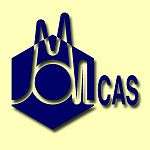MOLCAS
 | |
| Developer(s) | Lund University |
|---|---|
| Stable release |
8.0
/ June 2014 |
| Operating system | Linux, Unix and like operating systems, Microsoft Windows, Mac OS X |
| Type | Computational Chemistry |
| License | Proprietary |
| Website |
www |
MOLCAS is an ab initio computational chemistry program, developed as a joint project by a number of international institutes. Focus in the program is placed on methods for calculating general electronic structures in molecular systems in both ground and excited states. The binaries of the package are distributed free of charge to academic users (see external links below).
Capabilities
- Ab initio Hartree–Fock (HF), Density functional theory (DFT), second order Møller–Plesset perturbation theory, MCSCF, MRCI, CC, ((X)MS-)CASPT2 wavefunctions and energies[1]
- Analytic gradient geometry optimization based on HF, DFT, CASSCF, and RASSCF wavefunctions
- Cholesky decomposition (CD) and Resolution of the identity (RI) techniques for HF, DFT, CASSCF, CC, MBPT2, and CASPT2.
- Analytical gradients and non-adiabatic coupling vectors.
- On-the-fly auxiliary basis function technique, aCD and acCD.
- CD/RI gradients for DFT functionals.
- Numerical gradient geometry optimization based on CASPT2 wavefunctions.
- Excited state energies for all wavefunctions, and excited optimized geometries from state averaged CASSCF wavefunctions.
- Transition properties in excited states calculated at the CASSCF/RASSCF level, using a unique RASSCF State Interaction Method.
- Solvent effects can be treated by the Onsager spherical cavity model or Polarizable continuum model (PCM).
- Combined QM and molecular mechanics calculations for systems such as proteins and molecular clusters.
- The NEMO procedure for creating intermolecular force fields for MC/MD simulations; these force fields include electrostatics, induction, dispersion, and exchange-repulsion terms and are based on calculations for individual molecules.
- Graphical selection of the active space
- Tully Surface Hopping Molecular Dynamics
- Method for localization and characterization of conical intersections and seams
References
- ↑ Molcas 8: New capabilities for multiconfigurational quantum chemical calculations across the periodic table, doi:10.1002/jcc.24221
External links
- www
.molcas - MOLCAS homepage.org - www
.molcas - Graphical interface.org /GV - www
.kvant - MOLCAS@UU, a precompiled distribution of MOLCAS, free for academic users..kemi .uu .se /molcas
This article is issued from Wikipedia - version of the 5/20/2016. The text is available under the Creative Commons Attribution/Share Alike but additional terms may apply for the media files.